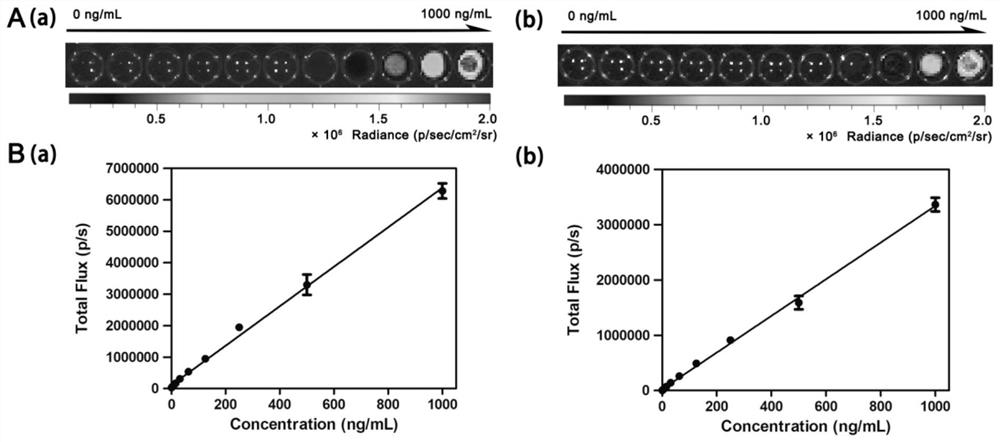Chemiluminescent probe for detecting fibroblast activating protein as well as synthesis method and application of chemiluminescent probe
A fibroblast, chemiluminescence technology, applied in chemical instruments and methods, chemiluminescence/bioluminescence, analysis by chemical reaction of materials, etc., to achieve important application value and expand the scope of application.
- Summary
- Abstract
- Description
- Claims
- Application Information
AI Technical Summary
Problems solved by technology
Method used
Image
Examples
Embodiment 1
[0041] Example 1: Synthesis of the adamantane-dioxetane chemiluminescent probe CFCL for the detection of fibroblast activation protein (see the attached figure 1 shown).
[0042] (1) The synthesis of compound 7, the specific steps are:
[0043] (1) Dissolve m-hydroxybenzaldehyde (25.6 g, 209.6 mmol, 1 equiv.) in 150 mL of 90 % acetic acid, and after the temperature of the reaction solution drops to 0°C, add tert-butyl hypochlorite (25.0 g, 230.6 mmol, 1.1 equiv.); HPLC monitors the reaction; after the reaction is complete, filter to obtain the product (recorded as compound 1), as a white solid 13.8g (42.2 % crude product yield); MS (ESI-): m / C 7 h 5 ClO 2 Theoretical values: 155.00, 156.99; Visible [M-H]-154.88, 156.88;
[0044] (2) Dissolve compound 1 (100 %, 10.8 g, 69.2 mmol, 1 equiv.) in 100 mL of methanol, add tetrabutylammonium tribromide (1.7 g, 3.5 mmol, 0.05 equiv.) and Trimethyl orthoformate (11.8 g, 110.8 mmol, 1.6 equiv.), reacted at room temperature for 4 ...
Embodiment 2
[0057] Example 2: Synthesis of an adamantane-dioxetane chemiluminescence probe BFCL for detecting fibroblast activation protein. (For the synthetic route see figure 2 shown), the specific steps are:
[0058] (1) Combine tert-butoxycarbonyl-glycine-proline-OH (1.1 g, 44.04 mmol, 1 equiv.) and ethyl 2-ethoxy-1(2H)-quinolinecarboxylate (2.0 g, 8.08 mmol , 2 equiv.) was dissolved in 20 mL of dichloromethane, and a dichloromethane solution of p-aminobenzyl alcohol (1.0 g, 8.08 mmol, 2 equiv.) was added dropwise. The reaction was monitored by high performance liquid chromatography. After the reaction, add appropriate amount of dichloromethane to dilute and wash with water. The organic phases were combined, dried with saturated sodium sulfate solid, the solvent was removed by rotary evaporation in vacuum, and purified by silica gel column chromatography. The obtained product (referred to as compound b1) was a white solid, 1.24 g (82.7 % yield);
[0059] (2) Compound b1 (50 mg, 0...
Embodiment 3
[0061] Example 3: CFCL or BFCL Determination of Fibroblast Activation Protein in Vitro.
[0062] Prepare a series of FAPα solutions with different concentrations, take 100 μL of each concentration into small wells of a black 96-well plate, add 100 μL of 40 μM CFCL or BFCL chemiluminescent probes to each well, and use Xenogen IVIS ® The in vivo imager takes pictures and performs quantitative analysis by the instrument's own software. Such as image 3 As shown, the response value increased with the increase of FAPα concentration, and there was a good linear relationship between the response value and the FAPα concentration.
PUM
| Property | Measurement | Unit |
|---|---|---|
| concentration | aaaaa | aaaaa |
Abstract
Description
Claims
Application Information
 Login to View More
Login to View More - R&D
- Intellectual Property
- Life Sciences
- Materials
- Tech Scout
- Unparalleled Data Quality
- Higher Quality Content
- 60% Fewer Hallucinations
Browse by: Latest US Patents, China's latest patents, Technical Efficacy Thesaurus, Application Domain, Technology Topic, Popular Technical Reports.
© 2025 PatSnap. All rights reserved.Legal|Privacy policy|Modern Slavery Act Transparency Statement|Sitemap|About US| Contact US: help@patsnap.com



